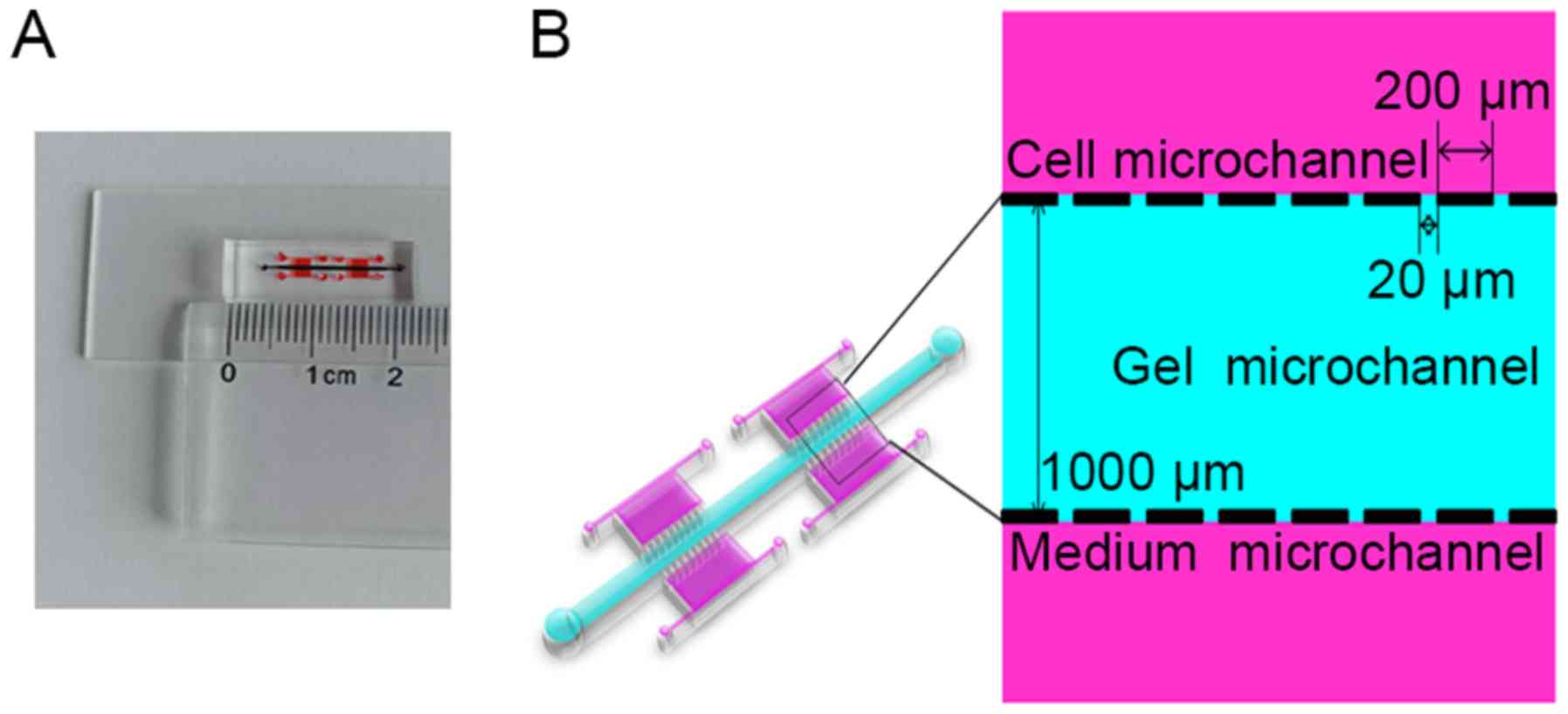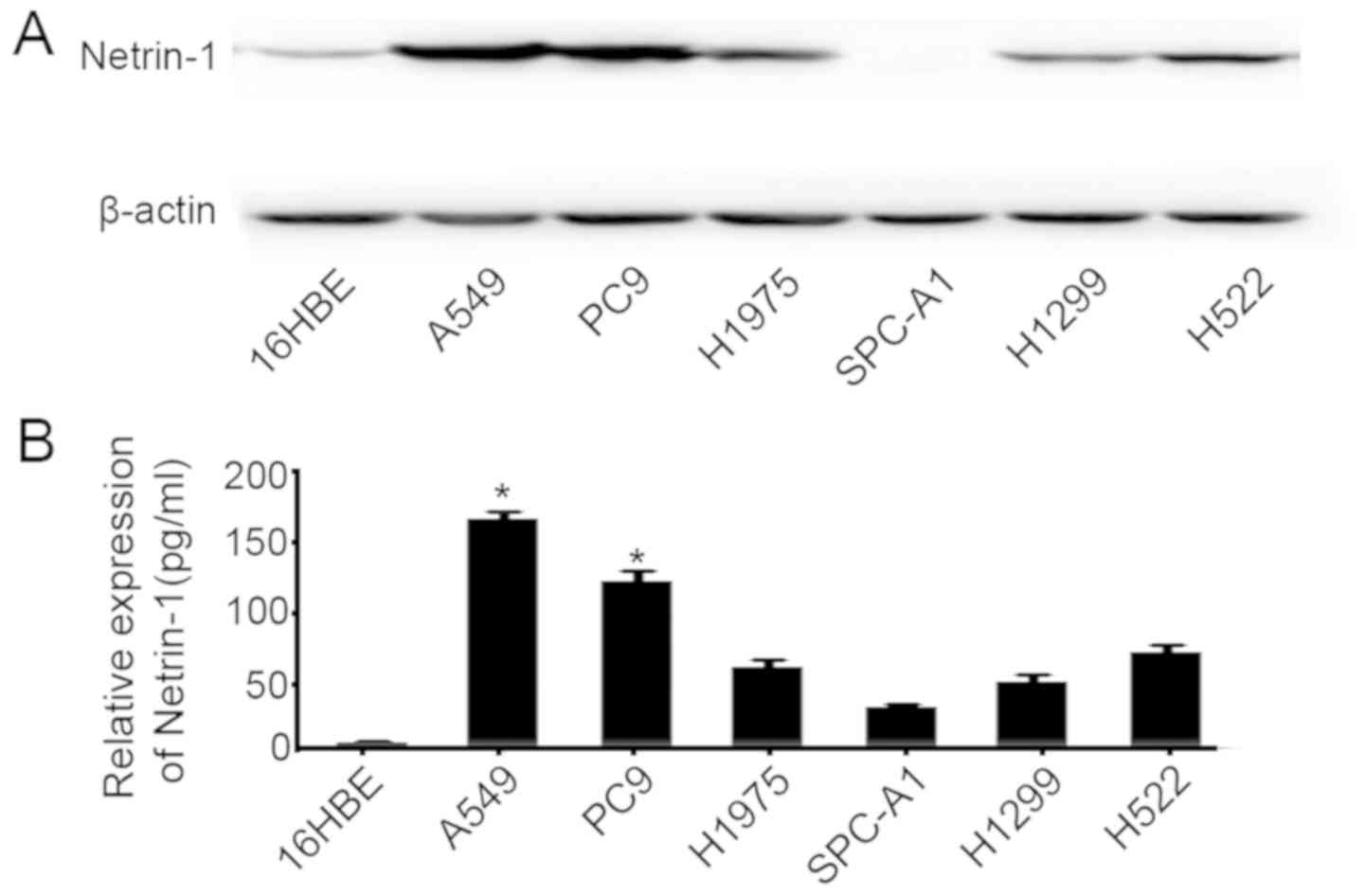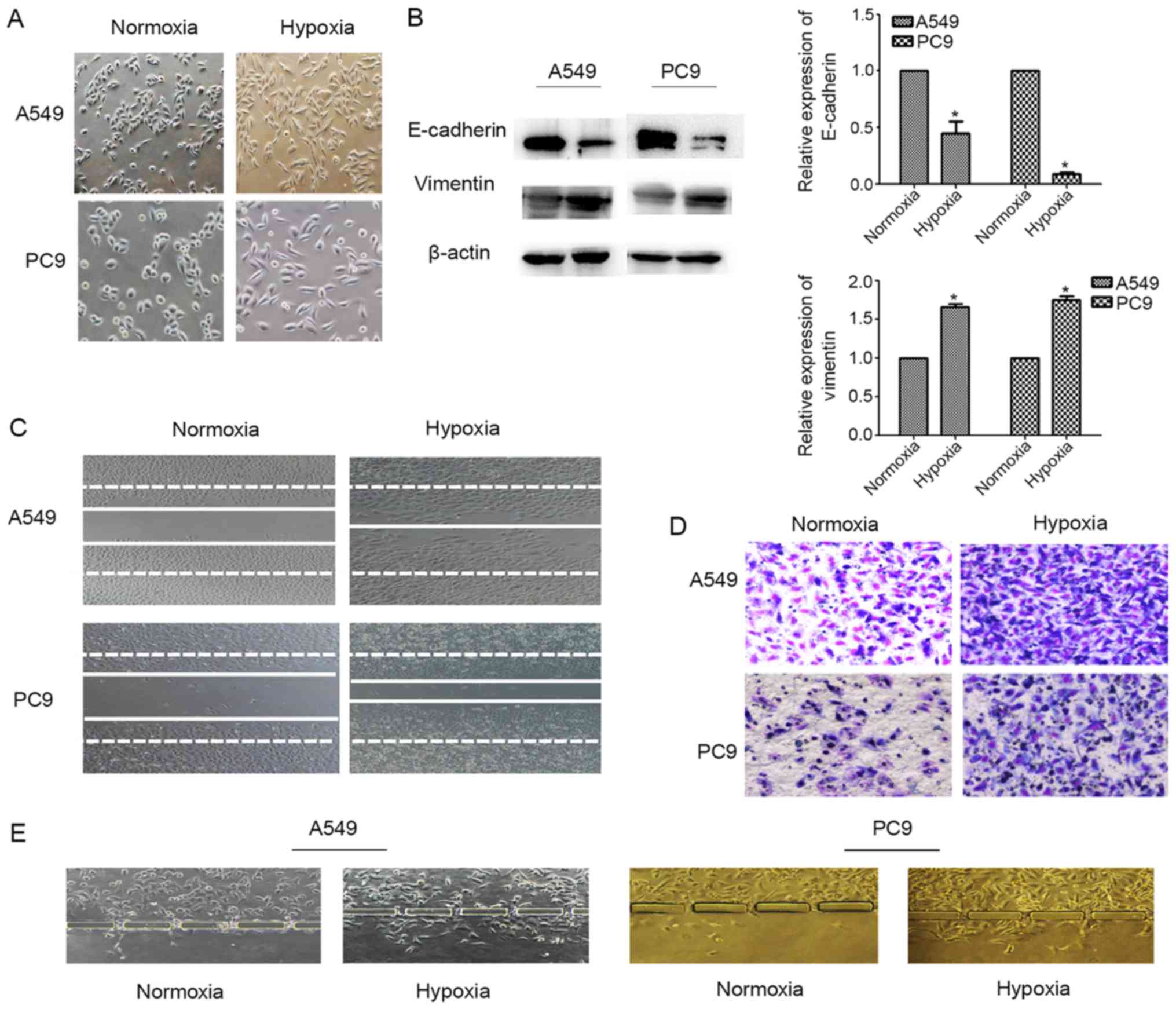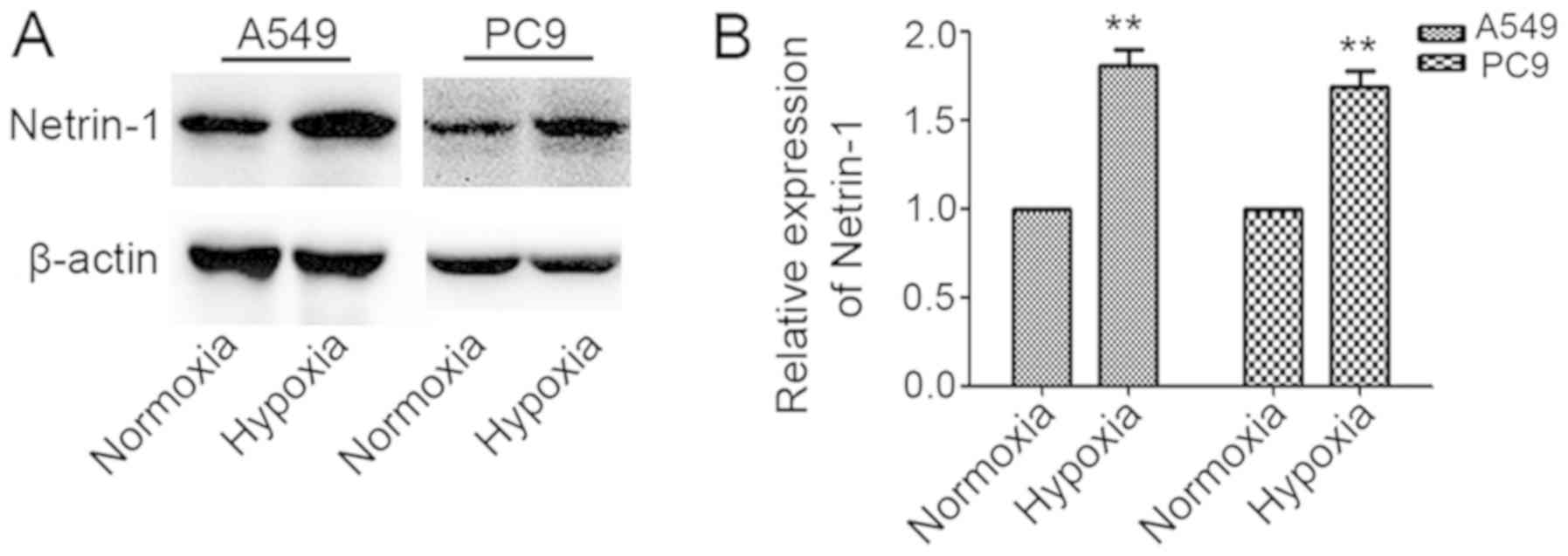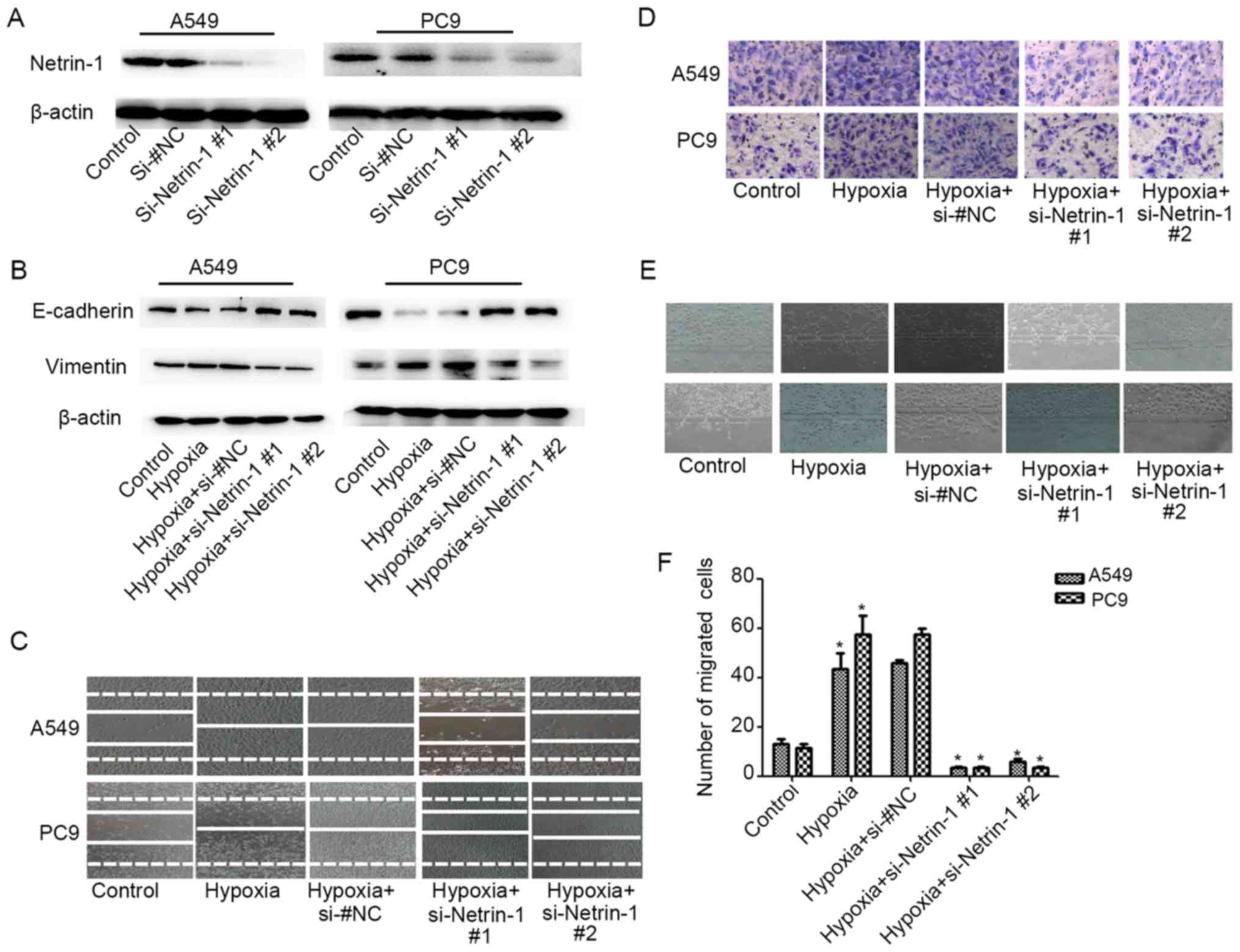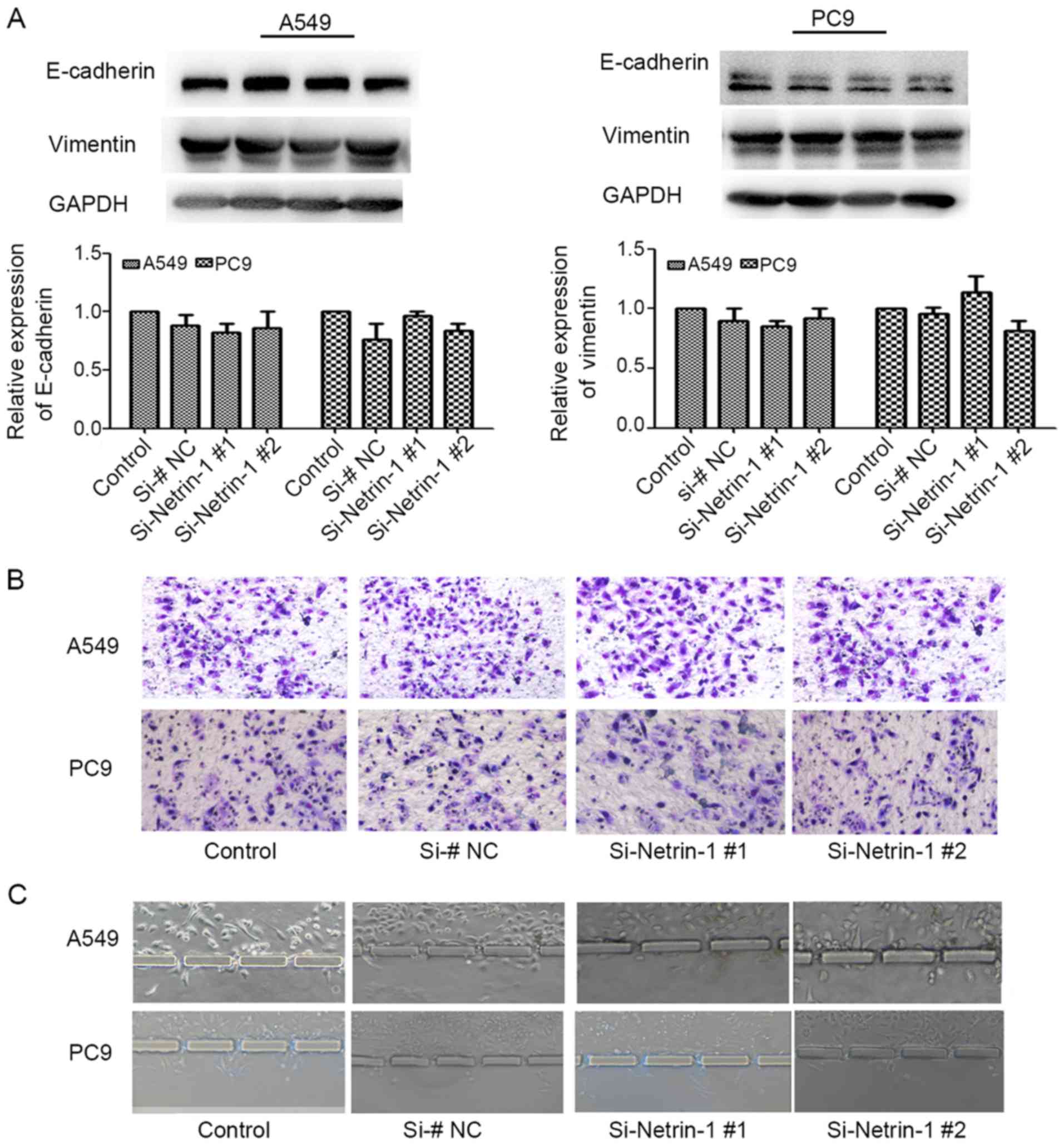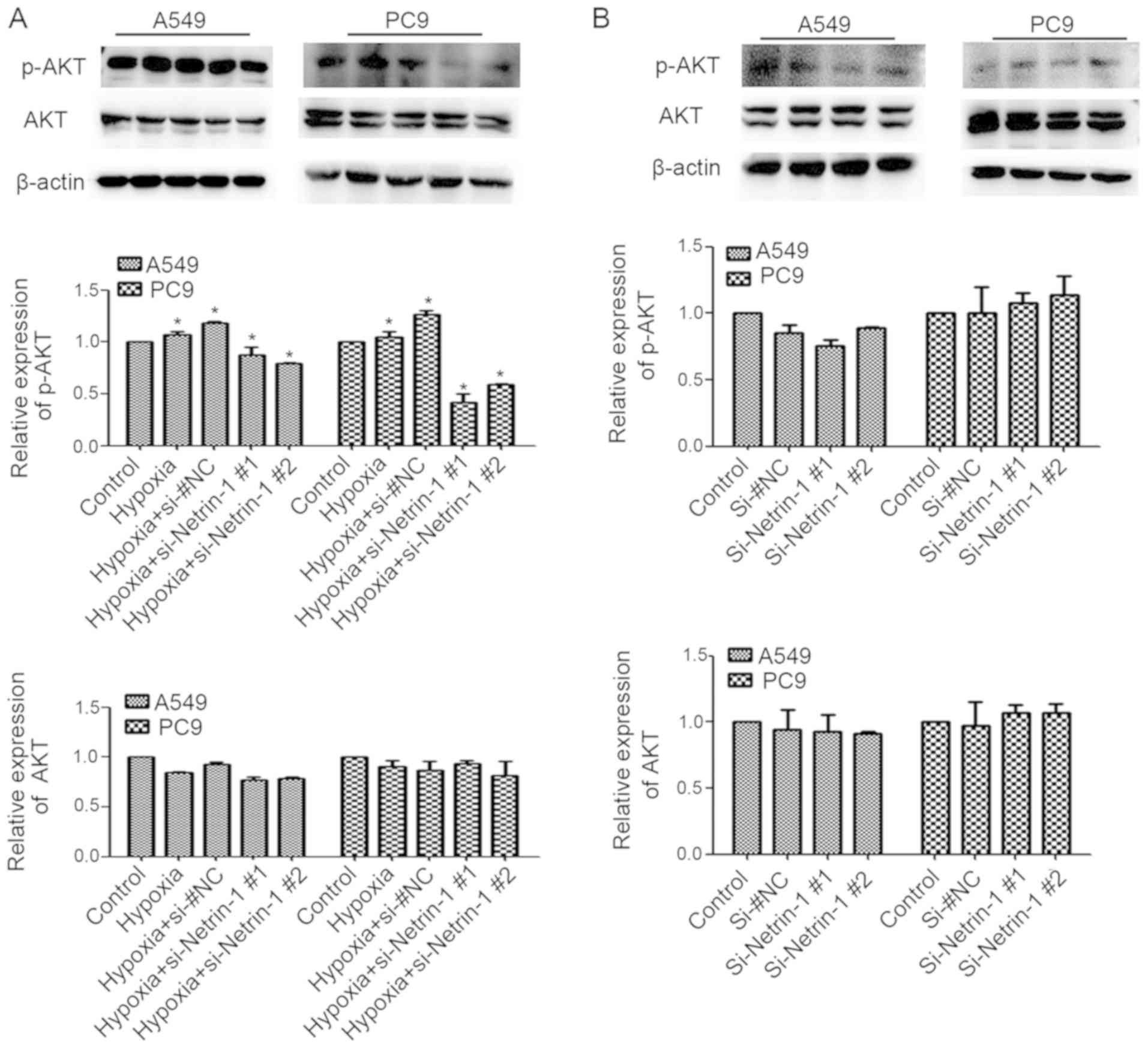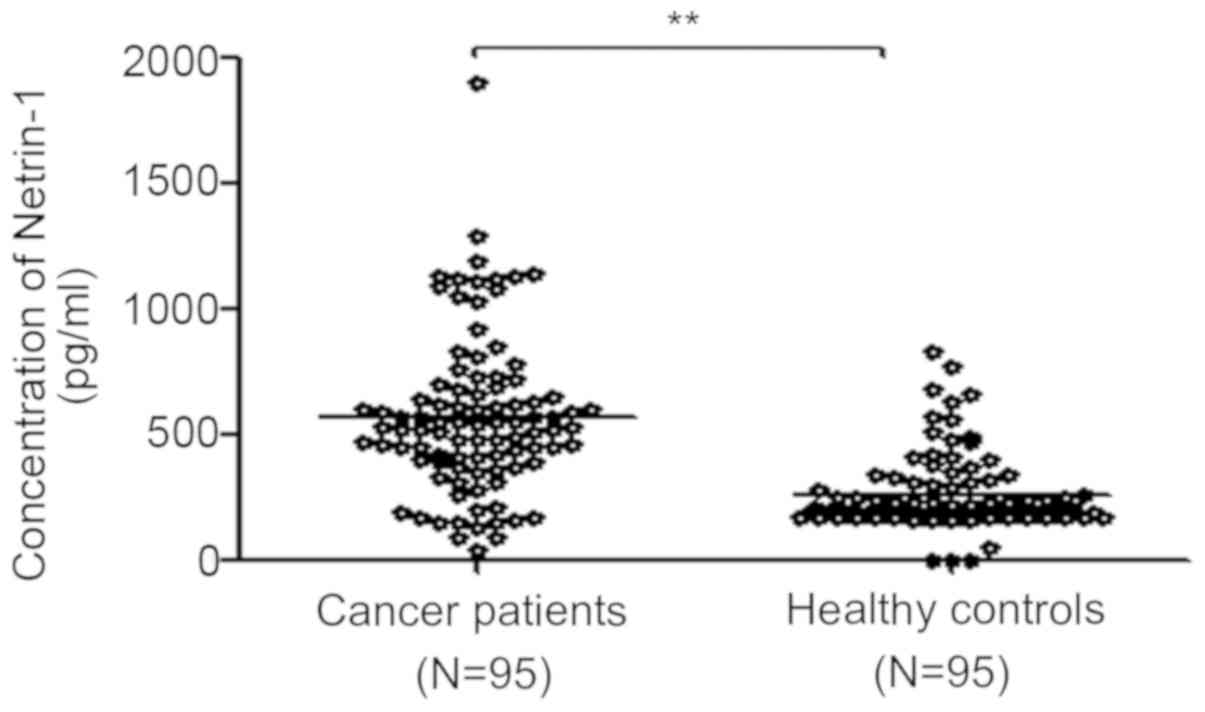|
1
|
Torre LA, Bray F, Siegel RL, Ferlay J,
Lortet-Tieulent J and Jemal A: Global cancer statistics, 2012. CA
Cancer J Clin. 65:87–108. 2015. View Article : Google Scholar : PubMed/NCBI
|
|
2
|
Shaikh D, Zhou Q, Chen T, Ibe JC, Raj JU
and Zhou G: cAMP-dependent protein kinase is essential for
hypoxia-mediated epithelial-mesenchymal transition, migration, and
invasion in lung cancer cells. Cell Signal. 24:2396–2406. 2012.
View Article : Google Scholar : PubMed/NCBI
|
|
3
|
Gunther S, Ostheimer C, Stangl S, Specht
HM, Mozes P, Jesinghaus M, Vordermark D, Combs SE, Peltz F, Jung
MP, et al: Correlation of Hsp70 Serum Levels with Gross Tumor
Volume and Composition of Lymphocyte Subpopulations in Patients
with Squamous Cell and Adeno Non-Small Cell Lung Cancer. Front
Immunol. 6:5562015. View Article : Google Scholar : PubMed/NCBI
|
|
4
|
Foss KM, Sima C, Ugolini D, Neri M, Allen
KE and Weiss GJ: miR-1254 and miR-574-5p: serum-based microRNA
biomarkers for early-stage non-small cell lung cancer. J Thorac
Oncol. 6:482–488. 2011. View Article : Google Scholar : PubMed/NCBI
|
|
5
|
Wang S, Li E, Gao Y, Wang Y, Guo Z, He J,
Zhang J, Gao Z and Wang Q: Study on invadopodia formation for lung
carcinoma invasion with a microfluidic 3D culture device. PLoS One.
8:e564482013. View Article : Google Scholar : PubMed/NCBI
|
|
6
|
Zhao M, Zhang Y, Zhang H, Wang S, Zhang M,
Chen X, Wang H, Zeng G, Chen X, Liu G, et al: Hypoxia-induced cell
stemness leads to drug resistance and poor prognosis in lung
adenocar-cinoma. Lung Cancer. 87:98–106. 2015. View Article : Google Scholar
|
|
7
|
Ye LY, Chen W, Bai XL, Xu XY, Zhang Q, Xia
XF, Sun X, Li GG, Hu QD, Fu QH, et al: Hypoxia-Induced
Epithelial-to-Mesenchymal Transition in Hepatocellular Carcinoma
Induces an Immunosuppressive Tumor Microenvironment to Promote
Metastasis. Cancer Res. 76:818–830. 2016. View Article : Google Scholar : PubMed/NCBI
|
|
8
|
Zhang L, Huang G, Li X, Zhang Y, Jiang Y,
Shen J, Liu J, Wang Q, Zhu J, Feng X, et al: Hypoxia induces
epithelial-mesenchymal transition via activation of SNAI1 by
hypoxia-inducible factor-1α in hepatocellular carcinoma. BMC
Cancer. 13:1082013. View Article : Google Scholar
|
|
9
|
Chen S, Chen JZ, Zhang JQ, Chen HX, Yan
ML, Huang L, Tian YF, Chen YL and Wang YD: Hypoxia induces
TWIST-activated epithelial-mesenchymal transition and proliferation
of pancreatic cancer cells in vitro and in nude mice. Cancer Lett.
383:73–84. 2016. View Article : Google Scholar : PubMed/NCBI
|
|
10
|
Masoud GN and Li W: HIF-1α pathway: Role,
regulation and intervention for cancer therapy. Acta Pharm Sin B.
5:378–389. 2015. View Article : Google Scholar : PubMed/NCBI
|
|
11
|
Vaupel P and Multhoff G: Accomplices of
the Hypoxic Tumor Microenvironment Compromising Antitumor Immunity:
Adenosine, Lactate, Acidosis, Vascular Endothelial Growth Factor,
Potassium Ions, and Phosphatidylserine. Front Immunol. 8:18872017.
View Article : Google Scholar
|
|
12
|
Nakamura H, Ichikawa T, Nakasone S,
Miyoshi T, Sugano M, Kojima M, Fujii S, Ochiai A, Kuwata T, Aokage
K, et al: Abundant tumor promoting stromal cells in lung
adenocarcinoma with hypoxic regions. Lung Cancer. 115:56–63. 2018.
View Article : Google Scholar : PubMed/NCBI
|
|
13
|
Dominici C, Moreno-Bravo JA, Puiggros SR,
Rappeneau Q, Rama N, Vieugue P, Bernet A, Mehlen P and Chédotal A:
Floor-plate-derived netrin-1 is dispensable for commissural axon
guidance. Nature. 545:350–354. 2017. View Article : Google Scholar : PubMed/NCBI
|
|
14
|
Xu K, Wu Z, Renier N, Antipenko A,
Tzvetkova-Robev D, Xu Y, Minchenko M, Nardi-Dei V, Rajashankar KR,
Himanen J, et al: Neural migration. Structures of netrin-1 bound to
two receptors provide insight into its axon guidance mechanism.
Science. 344:1275–1279. 2014. View Article : Google Scholar : PubMed/NCBI
|
|
15
|
Dun XP and Parkinson DB: Role of Netrin-1
Signaling in Nerve Regeneration. Int J Mol Sci. 18:182017.
View Article : Google Scholar
|
|
16
|
Chen J, Du H, Zhang Y, Chen H, Zheng M,
Lin P, Lan Q, Yuan Q, Lai Y, Pan X, et al: Netrin-1 Prevents Rat
Primary Cortical Neurons from Apoptosis via the DCC/ERK Pathway.
Front Cell Neurosci. 11:3872017. View Article : Google Scholar
|
|
17
|
Bai L, Mei X, Wang Y, Yuan Y, Bi Y, Li G,
Wang H, Yan P and Lv G: The Role of Netrin-1 in Improving
Functional Recovery through Autophagy Stimulation Following Spinal
Cord Injury in Rats. Front Cell Neurosci. 11:3502017. View Article : Google Scholar : PubMed/NCBI
|
|
18
|
Ko SY, Blatch GL and Dass CR: Netrin-1 as
a potential target for metastatic cancer: Focus on colorectal
cancer. Cancer Metastasis Rev. 33:101–113. 2014. View Article : Google Scholar
|
|
19
|
Lv J, Sun X, Ma J, Ma X, Zhang Y, Li F, Li
Y and Zhao Z: Netrin-1 induces the migration of Schwann cells via
p38 MAPK and PI3K-Akt signaling pathway mediated by the UNC5B
receptor. Biochem Biophys Res Commun. 464:263–268. 2015. View Article : Google Scholar : PubMed/NCBI
|
|
20
|
Akino T, Han X, Nakayama H, McNeish B,
Zurakowski D, Mammoto A, Klagsbrun M and Smith E: Netrin-1 promotes
medulloblastoma cell invasiveness and angiogenesis, and
demonstrates elevated expression in tumor tissue and urine of
patients with pediatric medulloblastoma. Cancer Res. 74:3716–3726.
2014. View Article : Google Scholar : PubMed/NCBI
|
|
21
|
Grandin M, Mathot P, Devailly G, Bidet Y,
Ghantous A, Favrot C, Gibert B, Gadot N, Puisieux I, Herceg Z,
Delcros JG, Bernet A and Mehlen P: Inhibition of DNA methylation
promotes breast tumor sensitivity to netrin-1 interference.
8:863–877. 2016.
|
|
22
|
Wang H, Zhang B, Gu M, Li S, Chi Z and Hao
L: Overexpression of the dependence receptor UNC5H4 inhibits cell
migration and invasion, and triggers apoptosis in neuroblastoma
cell. Tumour Biol. 35:5417–5425. 2014. View Article : Google Scholar : PubMed/NCBI
|
|
23
|
Gibert B and Mehlen P: Dependence
Receptors and Cancer: Addiction to Trophic Ligands. Cancer Res.
75:5171–5175. 2015. View Article : Google Scholar : PubMed/NCBI
|
|
24
|
Zhang Y, Wang B, Chen X, Li W and Dong P:
AGO2 involves the malignant phenotypes and FAK/PI3K/AKT signaling
pathway in hypopharyngeal-derived FaDu cells. Oncotarget.
8:54735–54746. 2017.PubMed/NCBI
|
|
25
|
Zhang PF, Li KS, Shen YH, Gao PT, Dong ZR,
Cai JB, Zhang C, Huang XY, Tian MX, Hu ZQ, et al: Galectin-1
induces hepato-cellular carcinoma EMT and sorafenib resistance by
activating FAK/PI3K/AKT signaling. Cell Death Dis. 7:e22012016.
View Article : Google Scholar
|
|
26
|
Yang X, Li S, Zhong J, Zhang W, Hua X, Li
B and Sun H: CD151 mediates netrin-1-induced angiogenesis through
the Src-FAK-Paxillin pathway. J Cell Mol Med. 21:72–80. 2017.
View Article : Google Scholar
|
|
27
|
Song J, Zhang Y, Zhang C, Du X, Guo Z,
Kuang Y, Wang Y, Wu P, Zou K, Zou L, et al: A microfluidic device
for studying chemotaxis mechanism of bacterial cancer targeting.
Sci Rep. 8:63942018. View Article : Google Scholar : PubMed/NCBI
|
|
28
|
Torre LA, Siegel RL and Jemal A: Lung
Cancer Statistics. Adv Exp Med Biol. 893:1–19. 2016. View Article : Google Scholar
|
|
29
|
Quéré G, Descourt R, Robinet G, Autret S,
Raguenes O, Fercot B, Alemany P, Uguen A, Férec C, Quintin-Roué I,
et al: Mutational status of synchronous and metachronous tumor
samples in patients with metastatic non-small-cell lung cancer. BMC
Cancer. 16:2102016. View Article : Google Scholar : PubMed/NCBI
|
|
30
|
Chu CY, Jin YT, Zhang W, Yu J, Yang HP,
Wang HY, Zhang ZJ, Liu XP and Zou Q: CA IX is upregulated in
CoCl2-induced hypoxia and associated with cell invasive potential
and a poor prognosis of breast cancer. Int J Oncol. 48:271–280.
2016. View Article : Google Scholar
|
|
31
|
Papanastasiou AD, Pampalakis G, Katsaros D
and Sotiropoulou G: Netrin-1 overexpression is predictive of
ovarian malignancies. Oncotarget. 2:363–367. 2011. View Article : Google Scholar : PubMed/NCBI
|
|
32
|
Harter PN, Zinke J, Scholz A, Tichy J,
Zachskorn C, Kvasnicka HM, Goeppert B, Delloye-Bourgeois C,
Hattingen E, Senft C, et al: Netrin-1 expression is an independent
prognostic factor for poor patient survival in brain metastases.
PLoS One. 9:e923112014. View Article : Google Scholar : PubMed/NCBI
|
|
33
|
An XZ, Zhao ZG, Luo YX, Zhang R, Tang XQ,
Hao D, Zhao X, Lv X and Liu D: Netrin-1 suppresses the MEK/ERK
pathway and ITGB4 in pancreatic cancer. Oncotarget. 7:24719–24733.
2016. View Article : Google Scholar : PubMed/NCBI
|
|
34
|
Han P, Fu Y, Liu J, Wang Y, He J, Gong J,
Li M, Tan Q, Li D, Luo Y, et al: Netrin-1 promotes cell migration
and invasion by down-regulation of BVES expression in human
hepatocellular carcinoma. Am J Cancer Res. 5:1396–1409.
2015.PubMed/NCBI
|
|
35
|
Ducarouge B, Delcros JG, Abès R,
Goldschneider D, Gibert B, Blachier J, Neves D, Mehlen P, Bernet A
and Depil S: Abstract 2921: Preclinical characteristics of NP137, a
first-in-class monoclonal antibody directed against netrin-1 and
inducing dependence receptors-mediated cell death. Cancer Res.
75(Suppl): 2921. 2015. View Article : Google Scholar
|
|
36
|
Fujiki K, Inamura H, Miyayama T and
Matsuoka M: Involvement of Notch1 signaling in malignant
progression of A549 cells subjected to prolonged cadmium exposure.
J Biol Chem. 292:7942–7953. 2017. View Article : Google Scholar : PubMed/NCBI
|
|
37
|
Hong CF, Chen WY and Wu CW: Upregulation
of Wnt signaling under hypoxia promotes lung cancer progression.
Oncol Rep. 38:1706–1714. 2017. View Article : Google Scholar : PubMed/NCBI
|
|
38
|
Zhou Z, Wang S, Song C and Hu Z:
Paeoniflorin prevents hypoxia-induced epithelial-mesenchymal
transition in human breast cancer cells. OncoTargets Ther.
9:2511–2518. 2016. View Article : Google Scholar
|
|
39
|
Zhang X, Cui P, Ding B, Guo Y, Han K, Li
J, Chen H and Zhang W: Netrin-1 elicits metastatic potential of
non-small cell lung carcinoma cell by enhancing cell invasion,
migration and vasculogenic mimicry via EMT induction. Cancer Gene
Ther. 25:18–26. 2018. View Article : Google Scholar
|
|
40
|
Wang H, Zhang C, Xu L, Zang K, Ning Z,
Jiang F, Chi H, Zhu X and Meng Z: Bufalin suppresses hepatocellular
carcinoma invasion and metastasis by targeting HIF-1α via the
PI3K/AKT/mTOR pathway. Oncotarget. 7:20193–20208. 2016.PubMed/NCBI
|



